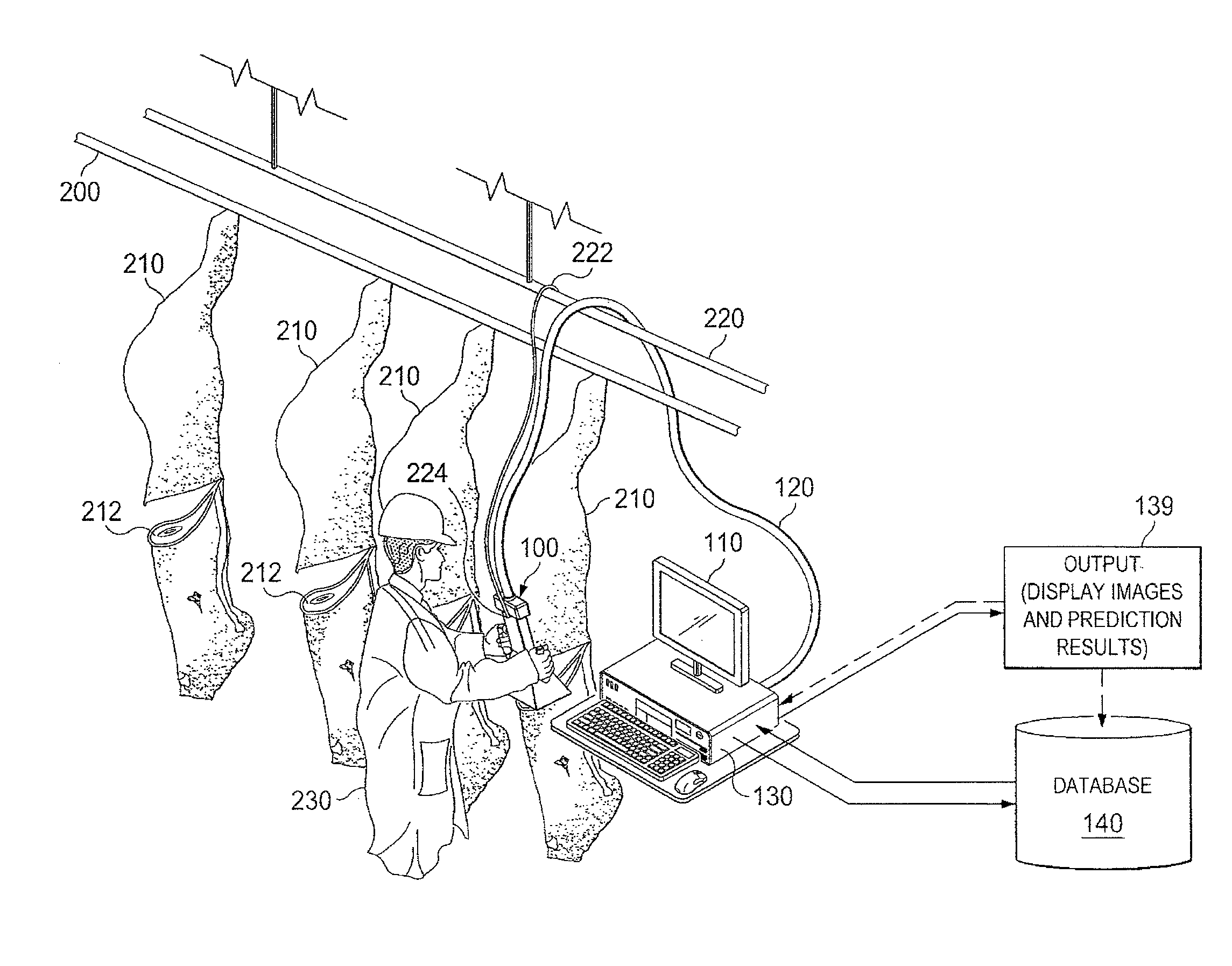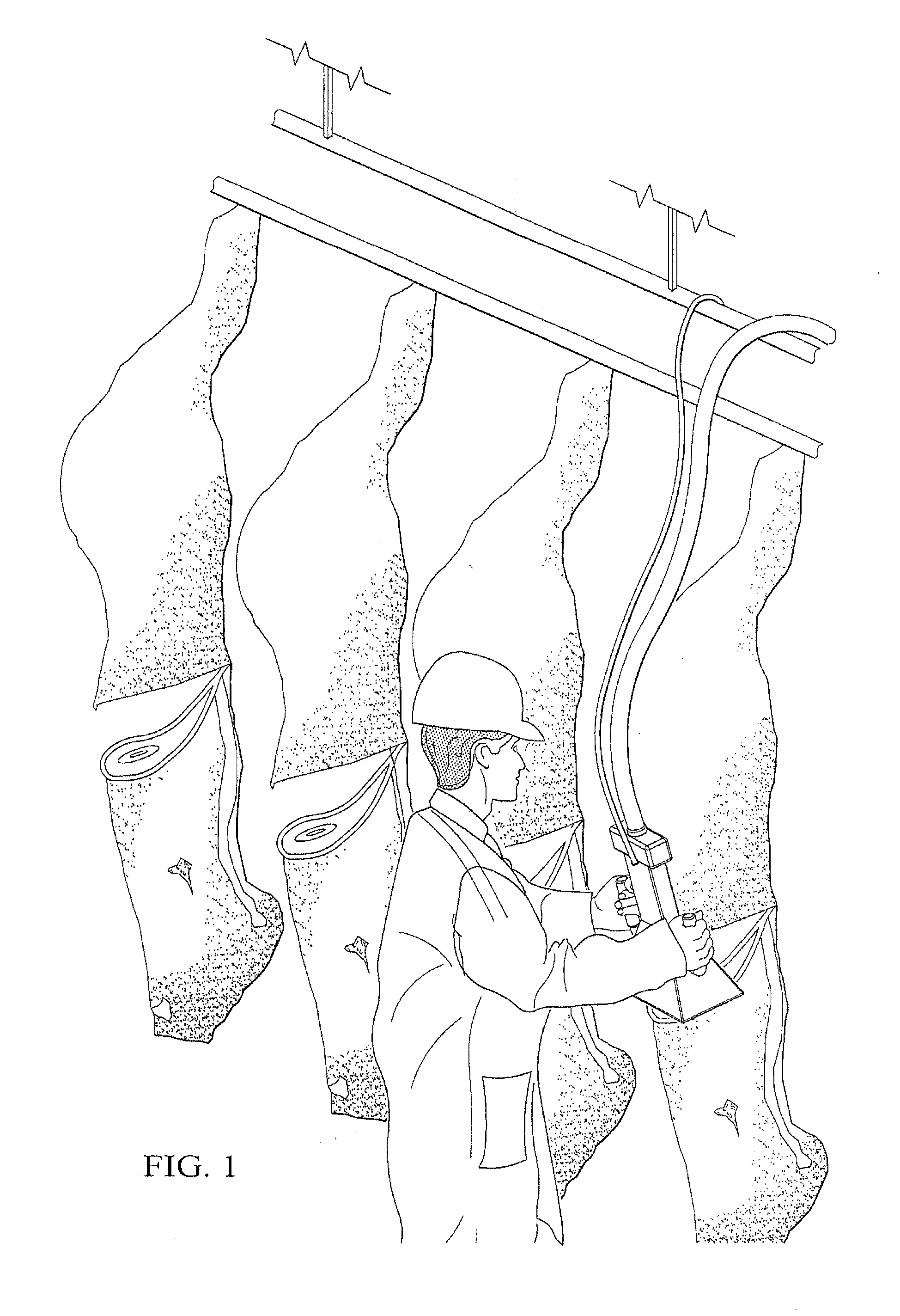System and Method for Analyzing Properties of Meat Using Multispectral Imaging
a multi-spectral imaging and meat technology, applied in the field of meat processing, analysis, classification, can solve the problems of lack of incentives for producers to supply a tender product, inability to incorporate a direct measure of tenderness in the usda grading system, and similar problems with pork and other meat products
- Summary
- Abstract
- Description
- Claims
- Application Information
AI Technical Summary
Benefits of technology
Problems solved by technology
Method used
Image
Examples
example 1
Multispectral Analysis of Beef
[0116]Twelve key wavelength bands in the NIR—1057, 1074, 1091, 1115, 1142, 1176, 1219, 1280, 1365, 1395, 1408, and 1462 nm were predetermined as related to tenderness classification. For each wavelength band, 8 image-textural features (mean, variance, homogeneity, contrast, dissimilarity, entropy, second moment, and correlation) were extracted using a co-occurrence matrix analysis, thus creating a total of 96 image-textural features per steak image. Using these 96 image-textural features, a canonical discriminant analysis was performed to create two new, uncorrelated variables (canonical variable 1 and 2: Can1 and Can2). These canonical variables are independent of each other and are the linear combination of original variables. Two models were developed: one for trained taste panel (TP) and one for slice shear force (SSF). Significant (p<0.10) correlations of individual textural features and / or the canonical variables were found with all of the biochem...
example 2
Evaluation of Eight Extracted Textural Features from Multispectral Images Captured at Key Wavelength Bands
[0117]Eight textural features were extracted using gray level co-occurrence matrix (GLCM) analysis from each of 12 identified bands. Textural features can also be extracted by other methods such as Gabor filters and / or wavelet analysis from each of those identified bands. Thus, 96 features were extracted. In addition to textural features, marbling features such as number and distribution of fat flecks, marbling texture, and % fat area can also be extracted. A stepwise discriminant regression method was used to select 46 variables. These variables were used to classify the steaks into two tenderness categories. The overall accuracy was 88% for SSF and 87% for taste panel (TP). The results are presented in Table 3 for predicting SSF and Table 4 for TP below.
TABLE 3Evaluation of multispectral imaging system for predicting SSFCross-validationReferenceActualPredictedResultsTenderTend...
example 3
Identification of Key Wavelength Bands for VNIR Multispectral Imaging System
[0121]PCA was implemented to reduce the spectral dimension of a Region of Interest (ROI) within a hyperspectral image. The optimal number of PC images was chosen with Eigen values significantly greater than zero. (Johnson, R. A., 1998. Applied Multivariate Methods for Data Analysis. Duxbury Press, New York, N.Y.) For this step, the first five PC images had Eigen values significantly greater than zero. These Eigen values explained over 90% of the variance of all bands for the image. In this study, ‘mosaic’ data transformation was used.
[0122]FIG. 9 shows the first three loading vectors. By “peak-valley analysis”, 12 key wavelengths can be identified.
[0123]Twelve key wavelength bands in the visible near-infrared (VNIR: 400-1000 nm) were identified. The wavelengths (455, 480, 520, 545, 568, 590, 604, 636, 722, 750, 814, and 850 nm) were identified as playing major roles in constructing the PC images (See FIG. 9)...
PUM
| Property | Measurement | Unit |
|---|---|---|
| wavelengths | aaaaa | aaaaa |
| wavelength | aaaaa | aaaaa |
| wavelength | aaaaa | aaaaa |
Abstract
Description
Claims
Application Information
 Login to View More
Login to View More - R&D
- Intellectual Property
- Life Sciences
- Materials
- Tech Scout
- Unparalleled Data Quality
- Higher Quality Content
- 60% Fewer Hallucinations
Browse by: Latest US Patents, China's latest patents, Technical Efficacy Thesaurus, Application Domain, Technology Topic, Popular Technical Reports.
© 2025 PatSnap. All rights reserved.Legal|Privacy policy|Modern Slavery Act Transparency Statement|Sitemap|About US| Contact US: help@patsnap.com



